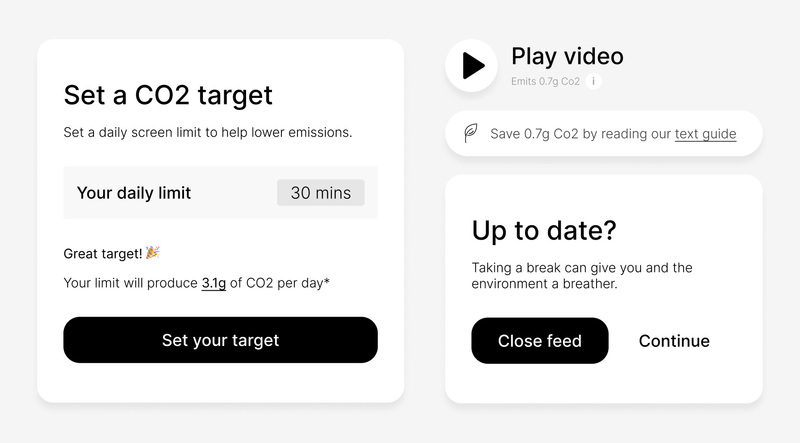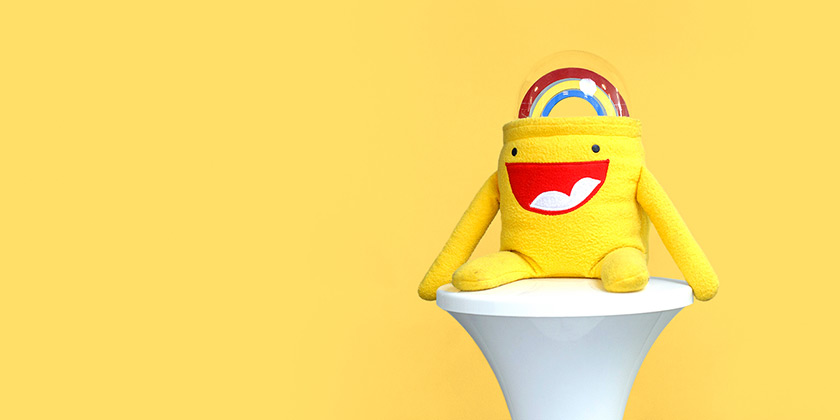Modern web design leaves a trace. Digital experiences demand energy. Power to connect, load, display, and function.
As devices and connections become more and more capable, our digital products have sought to deliver richer experiences. A designer in the not so distant past could only have dreamt of today’s capabilities. But whilst we might think that bigger means better, a saturation of quality hasn’t equated to efficiency.
For user experience, overloading screens with material may cause needless complexity. For our environment, richer experiences demand far more resources.
In 1996 our screens were blessed (or cursed?) with the animated sports comedy ‘Space Jam’, a 90s movie that needed a 90s website. Despite the mesmerising backgrounds and image links, this site is surprisingly efficient. By 2022 standards, this website knocks its newer sibling website out the court.

0.97g of CO2 seems insignificant next to the average of 180g of CO2 emitted from 1km of car travel. The problem lies within the frequency and scale of web traffic numbers. A tiny trace left by each and every page load builds up, and when added up, are comparable to the most polluting countries/industries in the world (such as the airline industry). Yet, we don’t often point the finger at reducing internet generated emissions.
Passive thinking would have us sitting comfortably in the notion that going digital means going green. This is wrong and like many industries, we need to think carefully about the impact of our work.
User experience is often seen as a set of principles that monitors the impact of a digital product carefully. A product that takes care of the user should be efficient and equate to less waste.
So, can user experience strategy help us in our quest to create sustainable design?
What has an influence on emissions?
What the user sees on their devices is the product of many moving parts. The user needs to navigate through a series of pages that contain a set of visual components that draw on asset loading resources. All of this stands on a product strategy that determines what these moving parts should be delivering for the user.
These facets pull together to build a digital experience. Each mechanism relies on a set of dependencies that ultimately lead to an influence on carbon emissions.
How we make digital products greener
Much of the potential impact comes down to the assets we choose to deploy on a web page.
We have the chance to:
-
Deploy lighter, optimised images
-
Reduce reliance on video
-
Use fonts efficiently
-
Reduce use of JavaScript
-
Avoid unnecessary third party tracking & advertising scripts
And we have the opportunity to think about:
-
If a resource-heavy design component is actually beneficial for the user
-
If pages can communicate effectively. (This may limit further need to for the user to mindlessly load more content)
-
How many steps a user will need to go through to complete a goal
-
What elements of the customer experience should be digitised
-
Using design to educate and inform of carbon impact
When we start to think about whether an element is necessary or if a journey is optimal, we start to move into the space of considering a user experience strategy. A good UX strategy will lean on good user research. From this we will learn what needs to be delivered, and why. A deep understanding of goals, constraints, and contexts will help us deliver a product which is feasible and desirable for the user in their everyday setting.
At the design stage, research can help us to answer difficult design choices. We may have the expertise and infrastructure to design an idea – but will it make a clear and concise experience for the user?
The architecture of an experience will steer the number of steps, define purposes of each page and resource, and ultimately what the user can do. By looking at this foundation of design we are showing care for the end user – and ultimately making each request for energy meaningful.
So does an investment in user experience equate to sustainable design?
Ideally, it should.
The trouble with disruptive thinking
The difficulty arises when we start to think back to the routes of many of the digital products we use today. They were fundamentally disruptive, for the market, and for the way the user thinks about the problems they need to solve.
A stellar UX strategy is a means to disrupt the marketplace through mental model innovation
— Jaime Levy [8]
A shake-up to the way we approach and think about problems can nudge us to improve our daily lives. At the same time, it can lead to sharp consequences. If the sights are set on a golden opportunity to solve a long time problem, and smash conceptions of complexity, it may be easy to overlook the downstream impact.
Silicon Valley’s old hat mantra of “Move fast and break things” is almost an ideal representation of what can lead to a counter balance away from sustainable thinking.
Can sustainable and disruptive UX strategy co-exist?
We may very well need it to be. Disruptive thinking will help in challenging the norms that got us in this situation. We have to promote a responsibility to view the bigger picture and consider impact. Our environment is far too fragile to view passively.
Tactics: Using UX to deliver efficiency (Delight and efficiency)
Generating delight for the user should be an aim for every design team. Although, how we define ‘delight’ should be considered carefully. The biggest, boldest (extravagant) experience won’t always win the hearts of your users. If it doesn’t fulfil this objective, then the heavier CO2 cost can’t be justified.
Systems that successfully anticipate user needs are the most fluid and efficient experiences. However, miscalculating what that anticipation entails can lead to further waste. If the system invests heavily on generating resources that may or may not be required by the user, we are running a risk. Consider the last time you flicked through a series of screens in haste to reach your desired content, utility or tool. Those screens required generation and effort to load.
If we have low confidence in our anticipation tactics, we need to put the user in control. Users can be asked if they need onboarding, video content, or other lengthy series of screens – before it’s loaded in full.
Generating and making good use of unbiased views from your end users can make priorities for your product’s user journey clear. Continued measurement can ensure that no part of the experience is unnecessary as the world changes around us. While the first release may not be 100% perfect, iterating between the problem and the solution can help uncover new ways to deliver efficiency.
How far do we need to go?
Design is a powerful construct. It has been used to influence and manipulate users on a large scale. Design that aims to incite emotions such as scarcity and urgency is a common sight.
These tactics get the best of our decision making processes. Ultimately they steer our mental muscle and we act on their conventions without knowing.
If we have a responsibility to reduce emissions, do we have a duty to install eco-friendly behaviour in users?

These draft UI elements aim to intervene at the right moments to nudge users towards careful consumption of content. Greater transparency can help raise the issue and give users the chance to think about the consequences of their actions.
This sounds viable in principle, but careful thought reveals a few issues.
Influencing users through design is a dangerous concept. An over reliance on these tactics can lead to mistrust and obstruct primary users journeys – two areas that a good user experience strategy should be aiming to avoid.
This is clearly a grey area of discussion. These tactics could on the surface, just be viewed as a quick win. If they are utilised they need to be backed by substance. Investment at a higher level will give the brand a narrative to trickle down genuine information at page or element level. Users could at the very least, be educated and made aware of the issue and what’s being done at a brand level.
Measurement: A focus on outcomes
Sustainable design demands a long-term vision. While there are key decisions to be made at initial development, a sustainable objective needs to be infinite. An over-reliance on short sighted metrics such as transactions or order value can pull a veil over true value.
Getting sales through the door is great but tactics that work towards a narrow sighted strategy will lead to inefficiency. A fixation on how many users click a button will miss the point of how micro interactions come together to form a holistic experience for users. Attention needs to go into details that prevent misinformation.
A focus on this area will not just lead to green web design, but a fulfilment in a responsibility to reduce tangible waste. Emissions are produced to get products to consumers and we want to make those journeys count.
Focusing on bigger, audacious goals can add perspective to what really matters for the business and the user.
Starting the conversation
Experiences are part of everyday life, digital or not. Carefully considering whether or not they generate value for the people using them can help us reduce CO2 output and compliment business needs. Users will return to systems that generated a positive experience. This is where harmony exists between user experience design, business objectives, and sustainability.
In the case of disruptive UX strategy, innovation can provide new delightful experiences that users never thought they needed. At the same time, designers can utilise high maturity research to gauge all aspects of the experience. Businesses have a responsibility to have sight of winners and losers.
There is no clear, one size fits all strategy to deliver a sustainable user experience strategy. We just have a responsibility to create efficient, inclusive, and considered designs.
References and reading list:
[2] https://www.wholegraindigital.com/digitaldeclutter/
[4] https://www.websitecarbon.com
[5] https://news.mit.edu/2021/how-to-reduce-environmental-impact-next-virtual-meeting-0304
[6] https://abookapart.com/products/sustainable-web-design
[7] https://www.wholegraindigital.com/blog/website-energy-efficiency/
[8] UX strategy, Jamie Levy
We are Kyan, a technology agency powered by people.



